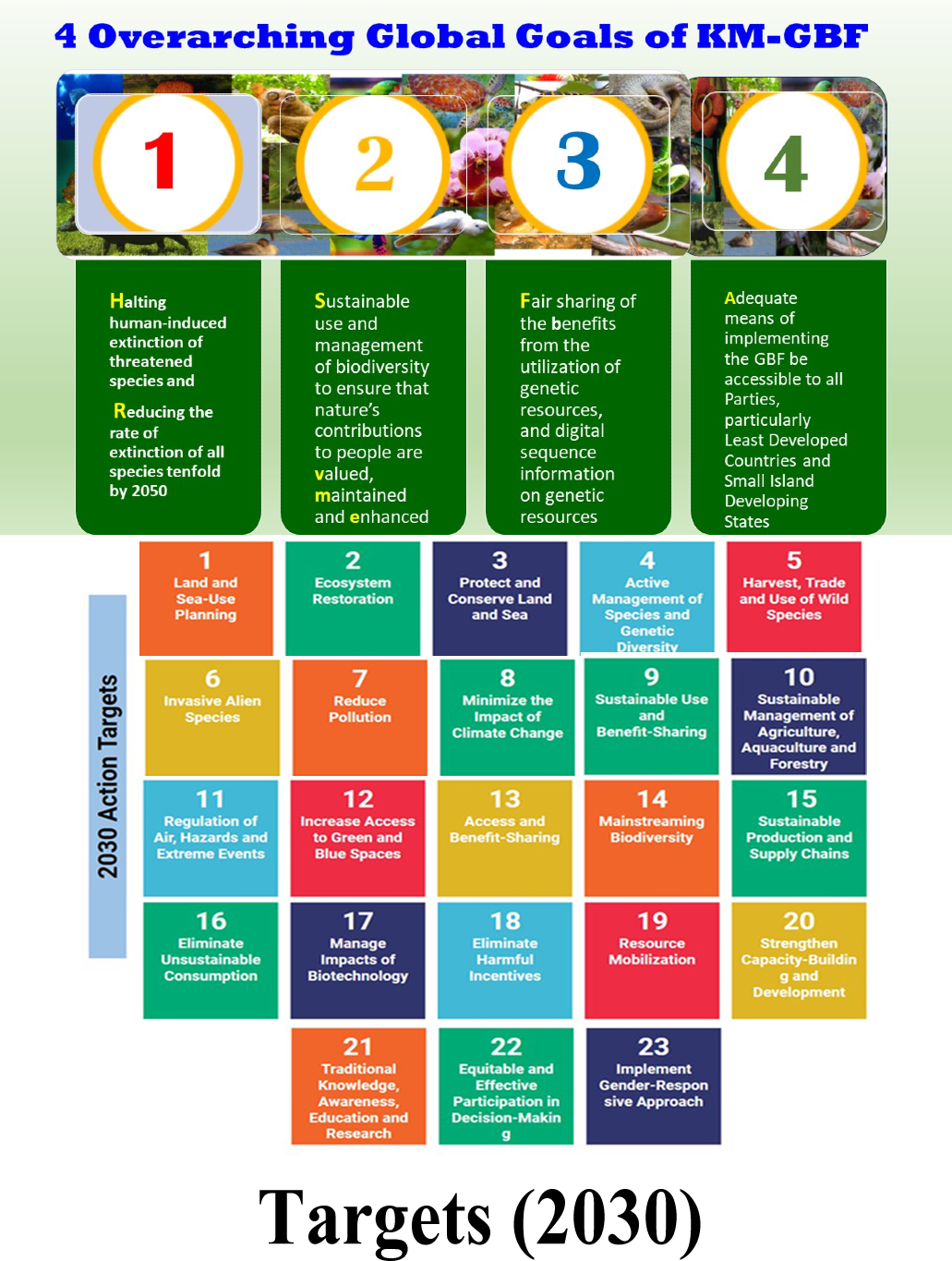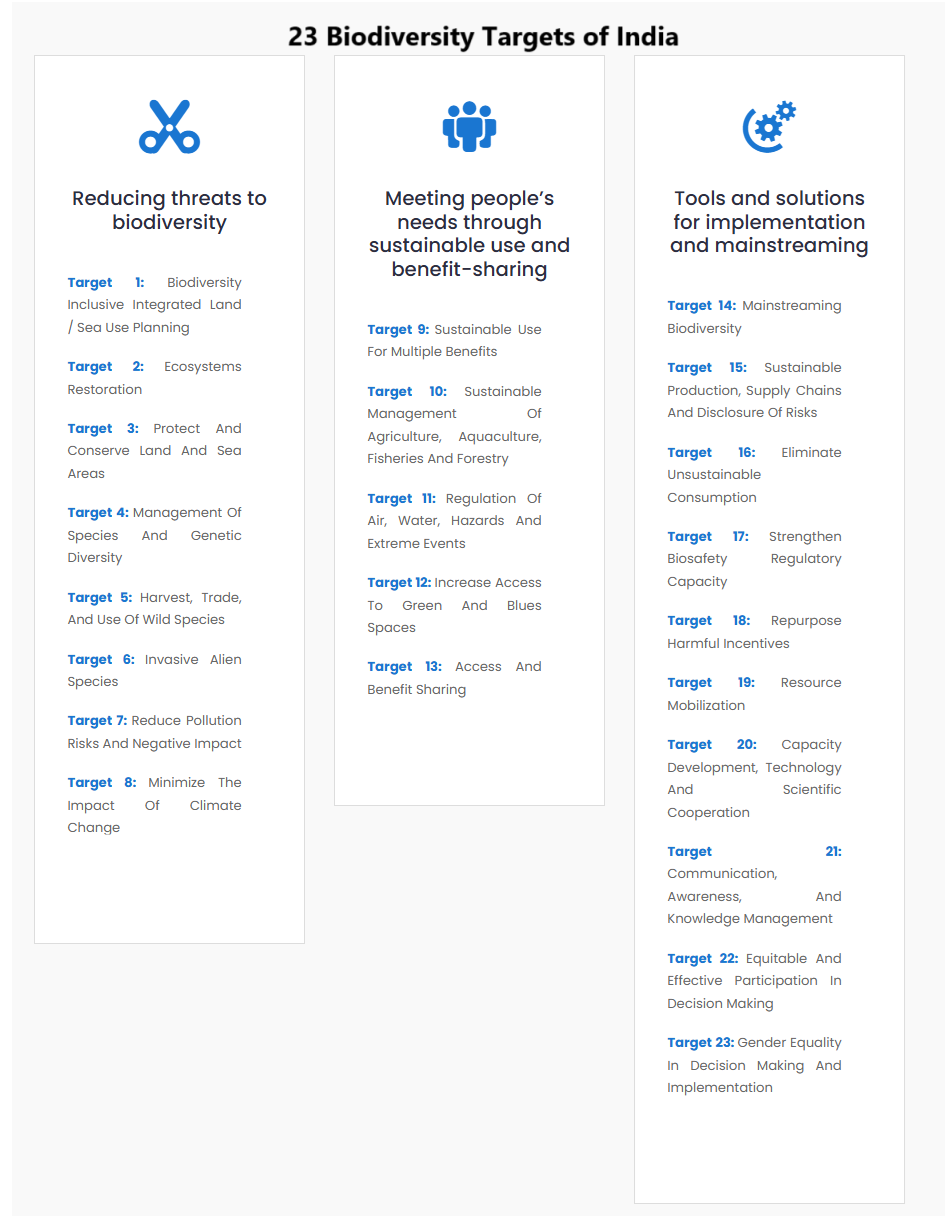Biodiversity & Environment
Protected Planet Report 2024
- 08 Nov 2024
- 11 min read
For Prelims: Protected Planet Report, International Union for Conservation of Nature, Kunming-Montreal Global Biodiversity Framework, Conference of the Parties (COP 15), United Nations Environment Programme, Aichi Biodiversity Targets
For Mains: National Biodiversity Strategy and Action Plan, Protected Areas and Biodiversity Conservation, Biodiversity and Climate Change
Why in News?
The Protected Planet Report 2024, produced by the UNEP– World Conservation Monitoring Centre (UNEP-WCMC) and the IUCN and its World Commission on Protected Areas (WCPA), is the first comprehensive evaluation of the global status of protected and conserved areas.
- It highlights both the progress made and the challenges ahead in achieving Target 3 of the Kunming-Montreal Global Biodiversity Framework(KM-GBF).
What is the Target 3 of the Kunming-Montreal GBF?
- The KM-GBF was adopted at the 15th COP of the UN Convention on Biological Diversity (CBD).
- This framework sets out an ambitious pathway to reach the global vision of a world living in harmony with nature by 2050, with 4 goals for 2050 and 23 targets for 2030.
- Target 3: Ensure and enable that by 2030 at least 30% terrestrial, inland water, coastal, and marine areas, especially those critical for biodiversity, are effectively conserved and managed through well-connected, ecologically representative, and equitably governed protected areas.
- This includes recognizing indigenous and traditional territories and integrating these areas into wider landscapes and seascapes, while ensuring sustainable use aligns with conservation goals and respects the rights of Indigenous peoples and local communities.
Key Terms
- Protected Area: Defined by the CBD as “a geographically defined area, which is designated or regulated and managed to achieve specific conservation objectives”.
- IUCN, along with the UNEP–WCMC, maintains a global database of protected and conserved areas.
- Indigenous and Traditional Territories: As per CBD, these are the areas with unique and significant biodiversity owned/occupied/managed by indigenous peoples and local communities.
What are the Key Highlights of the Protected Planet Report 2024?
- Global Coverage Progress: 17.6% of land and inland waters, and 8.4% of oceans and coastal areas are under protection. While progress has been made, the increase is minimal (less than 0.5% in both realms) since 2020.
- To meet the 30% target by 2030, additional protection is needed: 12.4% more land needs to be protected and 21.6% more ocean needs to be safeguarded.
- Progress in Ocean Conservation: Strongest progress since 2020 has been in the ocean, but most of this has been in national waters.
- In areas beyond national jurisdiction, coverage remains very low (<11% of the total area covered by marine and coastal protected areas).
- Challenges with Effectiveness and Governance: Less than 5% of land and 1.3% of marine areas have been assessed for management effectiveness. Only 8.5% of protected land is well-connected.
- Governance remains a challenge, with only 0.2% of land and 0.01% of marine areas assessed for equitable management.
- Underrepresentation of Biodiversity: Only one-fifth of areas identified as important for biodiversity are fully protected. Biodiversity is unevenly conserved.
- Though over two thirds of Key Biodiversity Areas (KBAs) are partially or fully covered by protected and conserved areas, the remaining one third (32%) of KBAs fall entirely outside these areas and lack formal protection.
- Indigenous Peoples' Role: Indigenous communities govern less than 4% of protected areas, despite holding 13.6% of global terrestrial areas outside formal protection.
- Governance data is lacking for these territories, and their contributions are often not fully recognized.
- Key Recommendations:
- Despite challenges, there is reason for optimism as 51 countries have already exceeded the 30% target on land, and 31 countries have done so at sea.
- With 6 years remaining, the report stresses that the 30% target is still achievable with accelerated efforts, global cooperation, and support for Indigenous Peoples.
- Insufficient availability of data is a long standing issue, especially regarding the positive biodiversity outcomes of protected and conserved areas, equitable governance for local people, and upholding the rights of women, Indigenous Peoples and local communities. Greater efforts are crucial in these areas.
- Indigenous People must be supported to act as stewards of their lands, their voices and knowledge must be heard and valued.
- Efforts must focus on not just increasing protected area coverage, but also ensuring these areas are well-connected and strategically located in biodiversity hotspots.
- Despite challenges, there is reason for optimism as 51 countries have already exceeded the 30% target on land, and 31 countries have done so at sea.
Key Institutions
- International Union for Conservation of Nature (IUCN): It was created in 1948 is a global membership organisation that includes governmental and civil society organisations. It serves as the authoritative body on the status of the natural world and the measures necessary to protect it.
- India became a State Member of IUCN in 1969, it provides invaluable scientific knowledge, policy guidance, and support for efforts aimed at conserving nature globally.
- UNEP-WCMC: It is a global leader in biodiversity, bridging science, policy, and practice to address nature’s crisis and promote a sustainable future. It operates as a collaboration between the United Nations Environment Programme (UNEP) and the UK charity WCMC.
- IUCN World Commission on Protected Areas (WCPA): It is a global network providing scientific, technical and policy advice, and advocating for effective area-based conservation measures that benefit biodiversity.
What are the Key Goals of India’s Biodiversity Strategy?
- NBSAP: The CBD mandates member countries including India, to develop a National Biodiversity Strategy and Action Plan (NBSAP) for conserving and sustainably using biodiversity.
- India recently updated its NBSAP to align with the KM-GBF, setting a goal to protect at least 30% of its natural areas by 2030.
- Originally created in 1999, India’s NBSAP was previously updated in 2008 and 2014 to meet the Aichi Biodiversity Targets, demonstrating India's ongoing commitment to addressing biodiversity threats.
- India recently updated its NBSAP to align with the KM-GBF, setting a goal to protect at least 30% of its natural areas by 2030.
- India’s Updated NBSAP: The updated NBSAP aims to protect 30% of terrestrial, inland water, coastal, and marine areas, aligning with the KM-GBF’s global goals.
- The plan emphasises the restoration of ecosystems such as forests and rivers, to ensure resources like clean water and air remain accessible.
|
Drishti Mains Question: Q. Evaluate India’s updated National Biodiversity Strategy and Action Plan (NBSAP) in the context of the Kunming-Montreal Global Biodiversity Framework. |
UPSC Civil Services Examination Previous Year Question (PYQ)
Prelims
Q. Consider the following statements : (2023)
- In India, the Biodiversity Management Committees are key to the realization of the objectives of the Nagoya Protocol.
- The Biodiversity Management Committees have important functions in determining access benefit sharing, including the power to levy collection fees on the access of biological resources within its jurisdiction.
Which of the statements given above is/are correct?
(a) 1 only
(b) 2 only
(c) Both 1 and 2
(d) Neither 1 nor 2
Answer: (c)
Q. With reference to ‘Global Environment Facility’, which of the following statements is/are correct? (2014)
(a) It serves as financial mechanism for ‘Convention on Biological Diversity’ and ‘United Nations Framework Convention on Climate Change’
(b) It undertakes scientific research on environmental issues at global level
(c) It is an agency under OECD to facilitate the transfer of technology and funds to underdeveloped countries with specific aim to protect their environment
(d) Both (a) and (b)
Ans: (a)
Q.“Momentum for Change: Climate Neutral Now” is an initiative launched by (2018)
(a) The Intergovernmental Panel on Climate Change
(b) The UNEP Secretariat
(c) The UNFCCC Secretariat
(d) The World Meteorological Organisation
Ans: (c)
Mains
Q. How does biodiversity vary in India? How is the Biological Diversity Act,2002 helpful in the conservation of flora and fauna? (2018)






